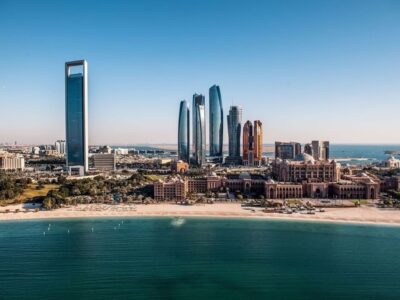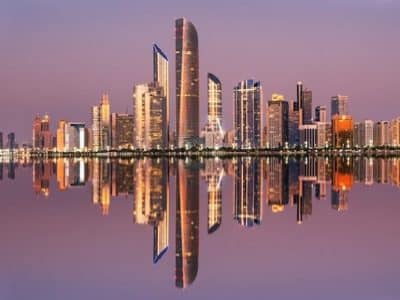Strong gross domestic product (GDP) growth, record budget surpluses, high regional liquidity and soaring foreign direct investment – economic figures for the oil-rich Gulf region are all on the rise, but although these figures point to positive economic development, what do they really mean for people’s everyday lives in the Arab world?
Mastercard’s recent survey on consumer confidence in the Middle East and North Africa (MENA) revealed that despite regional conflicts and political insecurity, people in the Middle East are more confident than ever before, with the region topping international rankings with an overall index figure of more than 83 out of 100.
Dr Nasser Saidi, chief economist at the Dubai International Financial Centre (DIFC), says that the consumer perception of the economy is “in line with actual economic growth” and reflects the “feel-good factor” of the region’s overall economic situation.
The study was conducted among a sample of 400 consumers in the key markets of Kuwait, Lebanon, Saudi Arabia and the UAE, and 600 consumers in Egypt. The index ranges from 0 to 100 with 50 as the mid-point, below 50 as pessimistic, and above 50 as optimistic.
It was conducted with five key “barometers” in mind, including employment, economy, regular income, stock market and quality of life in the different markets. The results reflect the expectations of participants for the economic climate and quality of life over the next six months.
The research showed unexpectedly high results, not only for the oil exporting states, but also in Egypt and Lebanon. Consumers positive outlook on stock market developments particularly surprised experts.
Oil Driver
Saidi explains that GCC governments have been using the current oil boom to reinvest in infrastructure and the private sector, as well as granting laws and rights to foreign workers who are increasingly deciding to reside permanently in the Gulf – all factors that helped to push confidence indicators up to unprecedented levels.
“The high growth of the oil exporting countries has a spillover effect into other less wealthy Arab nations. There is a high increase in the migrant population, and that helps distribute remittances to the less wealthy non-oil producing nations,” he says.
“The skilled labourers that move to the oil-exporting countries are, for the first time, also likely to stay in their new country of residence due to the introduction of labour laws and the foreign ownership of assets, he adds.
According to Saidi, the region’s private sector is leading the way with the accumulation of international reserves almost tripling from US$188.7bn (AED 692.5bn) in 2002 to US$517.7bn (AED 1.9 trillion) in 2006. Minor rises in inflation, coupled with strong global economic growth of 5% and continued regional growth, further supported a rise in confidence levels. The average real GDP growth in the MENA region has been 6.2% over the last three years, as opposed to 3.7% between 1999 and 2002.
“Enormous current surpluses, strong foreign direct investment and heavy portfolio investment are other drivers of the optimistic outlook,” Saidi says. He adds that the GCC is spending its excess oil revenues very conservatively with two thirds of the extra income being saved for other investments. He dismisses, however, the fear that a weaker oil price could slow down regional economies and says that a positive fiscal position for the GCC will remain until oil hits levels of between US$35 and US$38 (AED 128 – 140) a barrel. Another phenomenon is the emergence of Gulf companies transforming into multinationals, such as Emaar and Etisalat, with many
experts agreeing that businesses such as these support confidence – as well as increase tourism and send a positive global message from the region to the rest of the world.
Saidi also explains that the optimistic outlook of the equity markets is a further reflection of consumer confidence in the region’s business community. “The markets have been very volatile, but consumers expect them to bounce back, and they expect economic growth to continue, which will consequently have a positive effect on the shares of the listed companies. The stock market correction has been a call for action across the region for improved cooperate governance and transparency. These regulations have now started to show effect – so consumers believe that markets will recover,” he adds.
Varied Sentiment
Lebanon’s optimistic outlook of 67.6 was another survey high point for many experts. Saidi says: “Anyone familiar with the Lebanese situation knows that it has been a bumpy ride for this country. When we conducted the survey in September the conflict with Israel had just ended so sentiments were up. Maybe the next survey will show different results.”
However Egypt, with a figure of 78.2, was the region’s least optimistic market in the survey in the sense that positive sentiment declined from the previous year’s survey. “Economic growth has not been translated into more regular income increases for many in Egypt. The government did, however, introduce some reforms, such as reduced taxation and lower inflation, so the overall picture is positive,” says Denzil Lawson, general manager for the Middle East and the Levant at Mastercard.
Saudi Arabia topped the list of Middle Eastern countries with an index of 97.3, followed closely by Kuwait with 94.5. The UAE scored 80 and saw remarkable improvements in the employment and quality of life sentiments. “Consumers are feeling confident about the development in the region, and there has been continuous economic growth in the last three years,” adds Lawson.
Lawson points out that consumer confidence surveys indicate future market spending patterns. “There is an absolute correlation between consumer confidence and retail sales. In this region things are bullish but there used to be little data, so we launched the survey two years ago.” He recalls that in the year 2000 Hong Kong saw a severe dip in consumer confidence followed by a significant drop in retail spending.
“Pessimistic sentiments arose from high unemployment rates, which prompted consumers to save rather than spend their money. Data of this sort not only helps retailers get an idea of the future spending habits of their customers, but is also used by banks to develop their lending schemes,”
he adds.
The MENA region, Lawson explains, contains several mature markets, such as the UAE, that are very knowledgeable regarding lending and banking. Meanwhile, countries such as Egypt remain relatively underdeveloped. “Out of some 80 million Egyptians only 10 million own banks cards, and two million are credit card holders,” he says. “The consumer confidence index gives us an insight into the future retail spending of these potential customers.”
Nassim Ghrayeb, managing director of Siraj – the market research company that helped to create the region’s first business confidence index – says that confidence indexes are a general sentiment and not an absolute market forecast. “They produce significant factors and trends when companies consider their hiring and investment strategies. Business confidence is measured by revenue and profit outlooks, and assesses where stock markets are heading. In the region business confidence is high, and decision makers are optimistic, at least for the short-term future,” Ghrayeb observes.
United Arab Emirates
The current MasterIndex of 80.0 is higher than the previous two periods surveyed. Sentiment on Employment (79.0 vs 77.4 six months ago) and Quality of Life (80.6 vs 74.0) significantly improved. Sentiment on Economy (85.7 vs 84.5), Stock Market (76.5 vs 74.6) and Regular Income (78.4 vs 77.1) have remained almost the same.
Egypt
With a MasterIndex score of 78.2, consumers in Egypt are less optimistic than they were during the last MasterIndex survey (1H 2006). Sentiments for 1H 2006 were at a record high at 83.0 compared to these results. However, the score is much higher than both, the index a year ago (62.3) as well as the historical average (57.2) The latest survey scores are Economy (73.0 vs 79.3 six months ago), Quality of Life (77.7 vs 86.5), Employment (81.2 vs 80.5), Regular Income (83.0 vs 89.9) and Stock Market (75.9 vs 78.6).
Lebanon
In the second half (2H) of 2005 Lebanon consumer sentiments on all five economic factors were optimistic, with optimism dropping off in 1H 2006. The latest MasterIndex score of 67.6 is a significant increase of nearly 32% against the 51.3 rating achieved six months ago, and represents an improvement for all key barometers. The latest survey scores are Economy (71.1 vs 41.2 six months ago), Quality of Life (54.7 vs 46.5), Employment (87.0 vs 69.3), Regular Income (69.3 vs 58.5) and Stock Market (55.7 vs 41.3).
Kuwait
The current MasterIndex score in Kuwait of 94.5 is exactly the same as registered in 1H 2006. The Quality of Life score significantly improved, though the sentiment against the other factors declined marginally, resulting in an unchanged overall MasterIndex score. The scores were: Employment (92.4 vs 96.5 six months ago), Quality of Life (94.6 vs 87.7), Economy (96.9 vs 97.5), Regular Income (97.2 vs 97.7) and Stock Market (91.4 vs 93.0).
Saudi Arabia
The current MasterIndex of 97.3 ranks Saudi Arabia as top in the Middle East and Levant. The record all time high was in 2H 2004 with a result of 98.4 but the latest results are a close second. The current result shows that consumers are highly optimistic. The current scores are Employment (97.9 vs 85.5 six months ago), Economy (98.8 vs 89.7), Regular Income (96.5 vs 92.8), Stock Market (95.8 vs 82.1) and Quality of Life (97.6 vs 92.3).
Source: Mastercard




